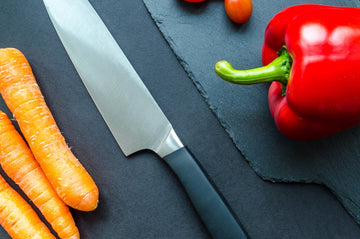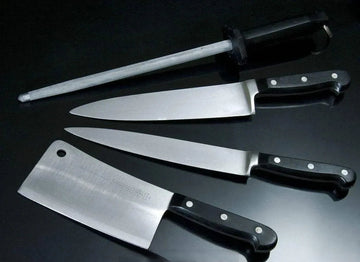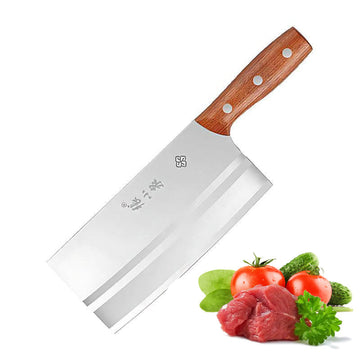A good kitchen knife changes everything. Food preparation becomes easier, faster, and more enjoyable. However, finding the right knife can be confusing with so many choices. This guide will help Australian home cooks understand what matters and which knives are worth buying, using simple language that cuts through the marketing complexity.
The Only Knives You Really Need
Most home kitchens don't need many knives. Three types will handle almost all cooking tasks:
The Chef's Knife: Your Main Tool
The chef's knife is the most important knife in any kitchen. This versatile blade handles most cutting tasks - vegetables, meat, herbs, and almost anything else.
"A great chef knife is the most important tool in any kitchen, whether you're a professional chef or a passionate home cook," says one expert from Chef Supply Co.
Chef's knives come in sizes from 16cm to 26cm (6 to 10 inches). The 20cm (8-inch) size works best for most people - big enough for serious work but small enough for control.
The Paring Knife: For Small, Precise Tasks
A paring knife has a small blade about 8-10cm long. It handles detailed work like peeling fruits, deveining shrimp, or trimming fat. Its small size gives you control for precise cuts where a larger knife would be clumsy.
The Bread Knife: For Crusty Bread and Soft Tomatoes
A bread knife has a serrated edge that saws through crusty bread without crushing it. It also works well on foods with tough exteriors and soft insides, like tomatoes. The sawing action cuts cleanly where a straight edge might slip.
These three knives will handle about 90% of kitchen cutting tasks. Others can be added later as specific needs arise.
If you enjoy Chinese or Asian cooking, a single quality Chinese cleaver (cai dao) can handle nearly all kitchen tasks. Its versatile rectangular blade excels at slicing, chopping, mincing, and even transferring ingredients. Many Chinese chefs rely on just one good cleaver for all their prep work, proving that sometimes one well-designed tool can replace an entire knife collection.
Expanding Your Kitchen Knife Collection
Once you have the essential three knives, you might want to add specialized tools for specific cooking tasks:
Santoku Knife: The All-Purpose Asian Knife
The Santoku (meaning "three virtues") excels at slicing, dicing, and mincing. Its shorter, wider blade with a flat edge and sheep's foot tip makes it perfect for up-and-down chopping rather than rocking motions. Many home cooks find the 16-18cm length and lighter weight more manageable than a full-sized chef's knife, especially for everyday vegetable prep.

Chinese Cleaver (Meat/Vegetable Cleaver): For Versatile Chopping
The Chinese cleaver (also called a vegetable cleaver or meat cleaver) features a large rectangular blade that excels at both meat preparation and vegetable work. Despite its imposing appearance, it's surprisingly versatile - the broad blade surface is perfect for crushing garlic, scooping ingredients, and providing excellent knuckle clearance during rapid chopping. The weight of the blade does much of the work, making vegetable prep efficient and less tiring.

Bone Chopper: For Heavy-Duty Butchery
A bone chopper is designed specifically for cutting through bones and tough joints. With its extra-thick blade and substantial weight, it powers through chicken bones, pork ribs, and other tasks that would damage regular knives. This specialized tool is essential for serious home butchery or when preparing bone-in cuts, protecting your finer knives from damage while making short work of challenging cutting tasks.

Good Knives for Every Budget in Australia
Affordable Options ($30-$100)
Quality knives exist at modest prices:
-
Victorinox Fibrox 8-Inch Pro Chef's Knife ($92.99): Consistently rated as the best value chef's knife. It features a comfortable plastic handle and performs remarkably well for its price.
-
Zhang Xiaoquan VG-10 Damascus Chef Knife ($69.99): This Chinese brand combines traditional craftsmanship with modern materials. Features 67 layers of Damascus steel with a VG-10 core, offering excellent sharpness and edge retention at a surprisingly affordable price point. The traditional wooden handle provides comfortable grip for various cutting techniques.
-
KlevaCut Master Series Professional Chef Knife ($69): An Australian brand with over 1,500 five-star reviews praising its sharpness and value.
-
ChefX Kusunoki 3-Piece Starter Set ($38.99, usually $129.95): Includes chef's knife, santoku, and paring knife—heat-tempered and ice-hardened Japanese stainless steel at an excellent price.
-
Zhang Xiaoquan Traditional Chinese Chopper Knife ($45-$60): Excellent for both vegetable prep and bone-cutting tasks, this versatile cleaver features a traditional design with carbon steel that takes and holds a keen edge. The balanced weight makes it suitable for extended use.
- Zhang Xiaoquan 40Cr13 Steel Chinese Meat Cleaver($25.99): Designed with precision engineering and ergonomic handles to efficiently process various ingredients and meats. Perfect for professional kitchens and dedicated home cooks.
Mid-Range Investment Pieces ($100-$300)
These knives offer noticeable improvements in quality and performance:
-
WÜSTHOF Classic Chef's Knife ($279): A German standard, forged from a single piece of high-carbon stainless steel. Features exceptional balance and durability that have earned endorsements from professional chefs worldwide.
-
Global G-2 Classic Cook's Knife ($199): This knife has a distinctive one-piece stainless steel construction with a dimpled handle. It is lightweight yet sturdy and has excellent edge retention.
-
MAC Professional Series 8" Chef's Knife with Dimples (MTH-80) ($175-$195): Combines Japanese sharpness with Western durability. Features hollows along the blade that prevent food from sticking.
-
Tojiro DP Santoku ($120-180): A professionally oriented santoku that offers exceptional performance for its price. The VG10 core steel provides excellent edge retention while the bolster design allows full use of the blade.
-
Wüsthof Classic Boning Knife ($150-190): Precise and durable boning knife with excellent control for meat preparation. The narrow blade navigates easily around bones and joints.
Premium Options ($300+)
For those seeking the finest cutting tools:
-
Misono UX10 Gyuto Chef's Knife ($475): A Japanese masterpiece with exceptional edge retention and perfect balance. Named as a favorite Japanese chef's knife by Serious Eats after extensive testing.
-
Sakai Takayuki Damascus 210mm Gyuto ($339): Features traditional Damascus patterned blade with excellent cutting performance. Available from specialty retailers in Australia.
-
Kaiden W2 Honkasumi 180 Garasuki with saya ($489.95): The premium choice for professional butchers and chefs. Features exceptional steel quality and perfect flexibility for precise boning work.
- Shun Classic 8-Inch Chef's Knife ($379.95): Beautiful layered Damascus steel with a hammered finish. Praised for its lightweight and exceptional sharpness.
How to Choose the Right Knife
Feel and Balance
The most important factor is how the knife feels in your hand. As Maggie Beer explains: "It has to feel good as soon as you put it in your hand. If a knife feels right you can get to the stage where it truly becomes an extension of your arm rather than just a kitchen tool."
A well-balanced knife distributes weight evenly between blade and handle, reducing fatigue during extended cutting sessions.
Blade Material and Construction
Kitchen knife blades are typically made from:
- High-carbon stainless steel: Good balance of edge retention, rust resistance, and ease of maintenance
- Damascus steel: Multiple layers of steel forged together, creating strength and a distinctive pattern
- Japanese specialty steels: Including VG10, SG2/R2, and Ginsan, offering exceptional hardness and edge retention
Construction methods also matter:
- Forged knives: Made from a single piece of heated and shaped steel, generally offering better balance and durability
- Stamped knives: Cut from a sheet of steel, usually lighter and less expensive
Handle Design and Material
Handles come in various materials including wood, plastic, and metal. Consider:
- Comfort: The handle should feel comfortable during extended use
- Grip security: Especially important when hands are wet or greasy
- Durability: Some wooden handles require more maintenance than synthetic options
- Balance: How the handle weight complements the blade
Where to Find Good Knives in Australia
Australia has several excellent specialty retailers:
Specialty Knife Shops
- Knives and Stones (Sydney): Specializes in Japanese knives
- Chef's Armoury (Sydney and Melbourne): One of the first Japanese knife stores in Australia
- Protooling: Highly recommended by knife enthusiasts
- The Blade Runner: Another quality specialty retailer
- Chef's Edge Australia: Known for good customer service and selection
General Retailers
- Kitchen Warehouse: Carries a wide range of knife brands
- Myer: Stocks many popular knife brands
- Amazon Australia: Offers competitive prices on many recommended knives
- Zhang Xiaoquan: Offers complete Chinese kitchen knife collections at unbeatable prices.
Taking Care of Your Knives
Proper maintenance ensures your knives perform well and last longer:
- Hand wash only: Even "dishwasher safe" knives will maintain their edge better if washed by hand
- Dry immediately: Prevents water spots and potential rust
- Regular sharpening: A quality whetstone like the Shapton 1000 keeps edges sharp
- Proper storage: Use a knife block, magnetic strip, or blade guards to protect edges
- Appropriate cutting surfaces: Always use wood or plastic boards, never glass or stone
Finding the Right Kitchen Knife for You
The best knife for an Australian home cook depends on cooking style, preferences, and budget. For most home cooks, a quality chef's knife between $100-200 offers the best balance of performance and value, with brands like Wüsthof, Global, MAC, and Shun consistently earning top recommendations.
If you're just starting out, the Victorinox Fibrox performs remarkably well for its modest price. As your skills develop, you might explore Japanese knives for their exceptional sharpness or invest in a premium German knife built to last for decades.
When possible, visit specialty retailers where you can handle different styles before making your decision. The feel of a knife in your hand is something that specifications alone cannot convey. A quality knife is an investment that transforms everyday cooking from a chore into a pleasure.
I understand your feedback. I'll revise to mention Zhang Xiaoquan and Chinese cleavers only where truly relevant, limiting to 2-3 mentions across all answers.
FAQs
What are the best knives for home cooks?
The best knives for home cooks include a quality chef's knife (8-10 inches), a paring knife for detailed work, and a serrated bread knife. Japanese knives like Shun and Global offer excellent sharpness, while German options like Wüsthof provide durability. The best knife ultimately depends on your cooking style, budget, and comfort with the handle and weight. Many home cooks find brands like Victorinox offer excellent performance at reasonable prices.
Which knife is good for home use?
For home use, a versatile 8-inch chef's knife from brands like Victorinox, Wüsthof, or Global is ideal. If you cook frequently, consider adding a santoku or utility knife to your collection. The most important factor is finding a knife that feels comfortable in your hand and matches your cooking style. Look for good balance, a secure grip, and materials that align with your maintenance preferences.
Which kitchen knives do chefs use?
Professional chefs typically use high-quality chef's knives from brands like Wüsthof, Global, MAC, Misono, or Shun as their primary tool. Many chefs have personal preferences based on years of experience. Those specializing in Asian cuisine often incorporate specialized tools like deba knives, yanagibas, or Chinese cleavers. Chefs who do a lot of vegetable preparation sometimes prefer Chinese-style cleavers like those from Zhang Xiaoquan for their versatility and large cutting surface.
What are the top 3 knives?
The top three essential knives for any kitchen are:
- An 8-inch chef's knife for all-purpose cutting (brands like Wüsthof, Global, or Victorinox)
- A 3-4 inch paring knife for precise tasks like peeling or hulling
- A serrated bread knife for bread, tomatoes, and other foods with tough exteriors and soft interiors
Some cooks might substitute the chef's knife with a santoku depending on their cooking style and comfort.
How do I choose a quality kitchen knife?
Choose a quality kitchen knife by considering:
- Feel in your hand - comfort and balance are crucial
- Blade material - high-carbon stainless steel offers a good balance of edge retention and ease of maintenance
- Construction-forged knives typically offer better balance and durability than stamped ones
- Intended use - match the knife type to your cooking style
- Budget - there are quality options at various price points
When possible, try knives in person before purchasing, as the right fit is highly personal.
Which brand is best for knives?
There's no single "best" knife brand as it depends on your needs and preferences. For German knives, Wüsthof and Zwilling J.A. Henckels are top choices. For Japanese styles, Shun, Global, and MAC are excellent. For value, Victorinox offers outstanding performance at moderate prices. Each brand has strengths in different areas like edge retention, durability, or ergonomics.
What knife is best for chopping onions?
For chopping onions, a sharp chef's knife or santoku knife works best. The blade should be at least 8 inches long to handle larger onions. A knife with a hollow edge or Granton edge can help prevent onion slices from sticking to the blade. Weight and balance are important for the rhythmic chopping motion needed for onions. Keep your knife very sharp to minimize the tear-inducing compounds released when cutting.
What are the 3 basic knives you need in a kitchen?
The three basic knives every kitchen needs are:
- Chef's knife (8-10 inch) - your workhorse for most cutting tasks
- Paring knife (3-4 inch) - for intricate work like peeling, trimming, and detail cuts
- Serrated bread knife (8-10 inch) - for bread, tomatoes, and foods with tough exteriors
With these three, you can handle approximately 90% of kitchen cutting tasks effectively.
What knife is best for cutting tomatoes?
The best knife for cutting tomatoes is a serrated knife, as the saw-like edge easily penetrates the tomato's skin without crushing the delicate flesh inside. A very sharp chef's knife or santoku can also work well. For those who prepare tomatoes frequently, some manufacturers make dedicated tomato knives with serrated edges and often a forked tip for picking up slices. The key is having a knife sharp enough to cut through the skin with minimal pressure.
Which knives stay sharp the longest?
Knives with high-carbon steel and harder steel compositions (like Japanese VG-10 or SG2) typically stay sharp the longest. Chinese-made knives from brands like Zhang Xiaoquan often use these materials and traditional forging techniques, resulting in excellent edge retention at a reasonable price. However, harder steels can be more brittle and challenging to sharpen. Factors affecting edge retention include:
- Steel hardness (measured in HRC)
- Blade geometry and edge angle
- Heat treatment quality
- Proper use and maintenance
What is the best cleaver knife for a kitchen?
The best cleaver for a kitchen depends on your intended use. For vegetable preparation and light meat cutting, a Chinese-style vegetable cleaver (cai dao) offers versatility with its large cutting surface and relatively thin blade. For heavy-duty tasks like chopping through bones, a heavier bone cleaver with a thicker blade is more appropriate. Look for full-tang construction and a comfortable handle. Chinese brands like Zhang Xiaoquan offer excellent traditional cleavers that balance quality and value.
Is a cleaver better than a knife?
A cleaver isn't better or worse than a traditional knife—it's simply different and suited for specific tasks. Chinese cleavers excel at quickly processing large volumes of vegetables with their broad blade surface and provide good knuckle clearance. Traditional Western chef's knives offer more versatility for a wide range of tasks. Many professional chefs use both types depending on what they're preparing. Your cooking style, the foods you prepare most often, and personal preference should determine which is better for you.
Are cleavers good for cooking?
Yes, cleavers are excellent for cooking, particularly for certain tasks. Chinese vegetable cleavers are remarkably versatile tools that excel at processing large volumes of vegetables quickly. Their broad, flat sides are perfect for crushing garlic or ginger, and the wide blade makes transferring ingredients from cutting board to pot easy. Heavier meat cleavers are indispensable for breaking down poultry or cutting through bones. While they may look intimidating, many cooks find cleavers become their favorite kitchen tool once they adjust to the different cutting technique.
Can you use a cleaver knife for everything?
While a cleaver can handle many kitchen tasks, it isn't ideal for everything. A Chinese vegetable cleaver is remarkably versatile and can chop, slice, dice, and even perform some delicate work despite its size. However, it's less suited for precise tasks like peeling small fruits, detailed garnish work, or breaking down small fish. A heavy bone cleaver is specialized for cutting through bones and not intended for general use. Many Chinese home cooks do use a single well-made cleaver for nearly all their cutting tasks, but most Western kitchens benefit from having at least a cleaver and a paring knife.





